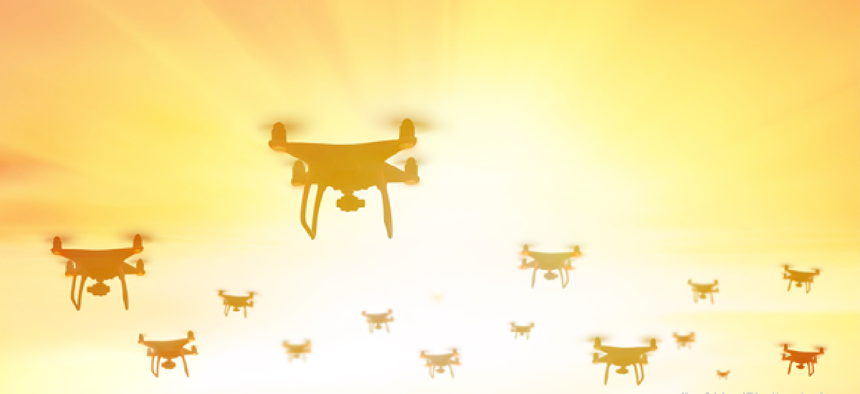FAA picks 10 for drone integration pilot program

The winners and their commercial partners will work with the FAA to develop UAS testing zones and build a regulatory framework for unmanned systems operation.
The Federal Aviation Administration announced the 10 projects selected for the Unmanned Aircraft Systems Integration Pilot Program. Selected from 149 applications, the winners were announced a little more than six months after President Donald Trump signed the memo creating the program to accelerate the integration of UAS into the national airspace.
The winners and their commercial partners will work with the FAA to develop UAS testing zones and build a regulatory framework for unmanned systems operation. They will get special permission to test drone applications that are currently banned or require a difficult to attain waiver, such as flying unmanned systems over people, beyond line of sight and at night. The program will also study the integration of drones into existing airspace operations, including counter-UAS capabilities, data exchanges between drones and other hardware and UAS traffic management.
The winners:
- Choctaw Nation of Oklahoma, Durant, Okla.
- City of San Diego, Calif.
- Innovation and Entrepreneurship Investment Authority, Herndon, Va.
- Kansas Department of Transportation, Topeka, Kan.
- Lee County Mosquito Control District, Ft. Myers, Fla.
- Memphis-Shelby County Airport Authority, Memphis, Tenn.
- North Carolina Department of Transportation, Raleigh, N.C.
- North Dakota Department of Transportation, Bismarck, N.D.
- City of Reno, Nev.
- University of Alaska-Fairbanks, Fairbanks, Alaska.
The Choctaw Nation will invest in mobile ground-based detect and avoid radars and plans to focus on “agricultural, public safety and infrastructure inspections, with planned Beyond Visual Line of Sight (BVLOS) operations over people and nighttime operations.”
The project in San Diego is being run out of the city’s homeland security office, but has multiple partners including local universities and industry, according to the San Diego Regional Economic Development Council. It will focus on border protection, delivery of packaged food, international commerce, smart city/autonomous vehicle interoperability and surveillance. The project plans to test 5G test networks, the 4G LTE cellular network and AT&T's FirstNet, the new national broadband public safety network.
The program in Virginia will focus on enabling technologies such as detect and avoid, Identification and tracking, radar systems, and mapping tools in a number of uses cases “including package delivery, emergency management, and infrastructure inspection,” according to a statement from Virginia Tech, one of the project partners.
Kansas will be studying BVLOS operations in rural communities and creating a drone traffic management system for precision agriculture. Kansas Secretary of Transportation Richard Carlson said the state’s DOT planned to test drones for “infrastructure inspections, search and rescue and remote area assessments.”
Ft. Myers will be using a 1,500-lb. UAS to help control mosquitos with ground-based detect and avoid radar systems, infrared imaging and satellite technology.
The Memphis-Shelby County Airport Authority plans to work on UAS traffic mangement that will communicate the location of both manned and unmanned traffic and support airport operations such as perimeter security surveillance. It will also look at package delivery applications.
North Carolina will be setting up drone delivery stations in local communities to help small businesses leverage UAS for commercial purposes. The N.C. Department of Transportation said plans to work with drone delivery companies Matternet and Zipline to use drones to deliver medical supplies across state lines.
North Dakota plans to focus on a variety of applications, but it is specifically interested in external systems, aircraft system technologies, training requirements and processes and procedure.”.
Reno will be testing the delivery of medical supplies and will build up infrastructure including radar and weather data to help facilitate these operations.
The University of Alaska-Fairbanks will be looking at pipeline inspection in remote areas with a specific interest in how harsh weather conditions affect drone use.
These projects will be collecting data for the next two and a half years that will be used to inform the FAA’s next set of drone regulations that will help to “safely integrate drones into our national airspace.” said Secretary of Transportation Elaine Chao said when announcing the winners.
Mark Blanks, the director of the Virginia Tech Mid-Atlantic Aviation Partnership, which will manage day-to-day operations of the project in Virginia, said this is just the beginning for drone implementation and these projects will help ensure drone development is done right.
“The days aren’t far off when millions of drones will be flying in the airspace,” Blanks said in a statement. “When you’re looking at an expansion of that scale, it’s critical to make sure it’s being handled carefully and safely.”





